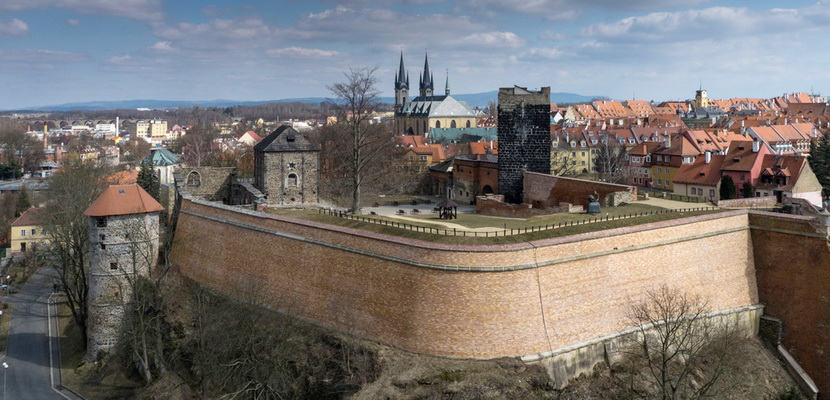
Castle Cheb
Castle Cheb
Cheb (Czech pronunciation: [ˈxɛp]; German: Eger) is a town in the Karlovy Vary Region of the Czech Republic, with about 33,000 inhabitants. It is situated on the river Ohře (also called Eger in German), at the foot of one of the spurs of the Smrčiny and near the border with Germany. Prior to 1945, which saw the expulsion of the German speaking population, the town was the centre of the German-speaking region known as Egerland, and was part of the Northern Austro-Bavarian dialect area. The name of the town was in 1061 recorded as Egire; in 1179 it was known as Egra; from 1322 as Eger and the surrounding territory as Regio Egere and Provincia Egrensis; after the 14th century also as Cheb orChba. From 1850 it was given the twin official names of Eger and Cheb. From 1938 to 1945 it was one of themunicipalities in Sudetenland.
The earliest settlement in the area was a Slavic stronghold at what is now known as the Cheb Castle complex[1], north of the town-centre. In 807 the district of today's Cheb was included in the new margraviate of East Franconia, which belonged at first to the Babenbergs, but from 906 to the margraves (marquis) ofVohburg. Depold II of Vohburg built the castle about which the town then grew. In 1179 town status was achieved. In 1149, by the marriage of Adelheid of Vohburg to the emperor Frederick I, Eger (Cheb) came into the possession of the House of Swabia, and remained in the hands of the emperors until the early 13th century, during which time it became an Imperial Free City. In 1265, it was taken by the king Ottokar II of Bohemia, who retained it for eleven years. After being repeatedly transferred from the one power to the other, according to the preponderance of Bohemia or the empire, the town and territory were finally incorporated into Bohemia in 1322, under John of Bohemia. Several imperial privileges, however, continued to be enjoyed by the town until 1849.
On 5 May 1389, during a Reichstag between King Wenceslausand a group of Imperial Free Cities of south-west Germany, thePeace of Eger was agreed upon, after Wenceslaus had failed to secure his interests in the city. It suffered severely during the Hussite Wars, during theSwedish invasion in 1631 and 1647, and in the War of the Austrian Succession in 1742. In 1634, during the Thirty Years' War, Albrecht von Wallenstein was killed here. George of Podebrady died 1471? (the main square is named after him) married his daughter and fathered two sons in the city. From the Middle Ages until 1945, the lands around the town were known by the German name Egerland. In 1723, Cheb became a free royal town. The northern quarter of the town was devastated by a large fire in 1809, and many middle-age buildings were irreplaceably destroyed. Until 1851, the renowned spa-town ofFrantiškovy Lázně belonged to the Magistrate of Cheb. The carbonated mineral water coming from these springs was delivered to spa visitors residing in Cheb. Geographers of the Austro-Hungarian monarchy proclaimed the nearby 939m high Tillen (Dileň in Czech) as thegeographical centre of Europe. This claim was documented on a copper plaque mounted at the summit. Austrian National Socialism and hence German National Socialism can trace its origins to Cheb when Franko Stein transferred a small newspaper (Der Hammer) from Vienna to Cheb in 1897. There he organized a German workers congress called the Deutschvölkischer Arbeitertag, which published the 25-point program.
The terms of the 1919 Treaty of St. Germain triggered civil unrest between the Sudeten German population and the newCzechoslovak administration, just as in the rest of theSudetenland. As elsewhere, protests in the town – now officially named Cheb – were eventually suppressed by force. On 3 October 1938, the town was visited by Adolf Hitler; shortly afterwards German troops marched into the Sudetenland and seized control. From 1938 until 1945, the town was annexed to Germany. On 1 May 1939, the town split away from the surrounding district to form its own municipal district together with the settlement of Matzelbach, and gave its name to the most westerly of the three administrative regions of the Sudetenland. The administrative seat of the Regierungspräsident lay in Karlsbad, however. Cheb was liberated by the 97th Infantry Division of the US Army on 25 April, 1945. After the end of World War II the region was returned to Czechoslovakia. Under the Beneš decrees of the same year, the German-speaking majority of the town was dispossessed of their homes and property, and was forcibly expelled from the country. In 1954, the town of Amberg in Germany adopted the expelled Sudeten German population from Cheb and the surrounding districts. On 24 August 2001, German Chancellor Gerhard Schröder and Czech Prime Minister Miloš Zeman visited theEuregio Egrensis (a cross-border initiative between districts in Bavaria, Saxony, Thuringia and Bohemia), and received the Freedom of the City of Cheb. In 2004, a town-twinning agreement was made with Hof in Bavaria. Since the fall of the Iron Curtain, Cheb has also had cordial relationships with the neighbouring German towns of Waldsassen and Marktredwitz.
Book Now